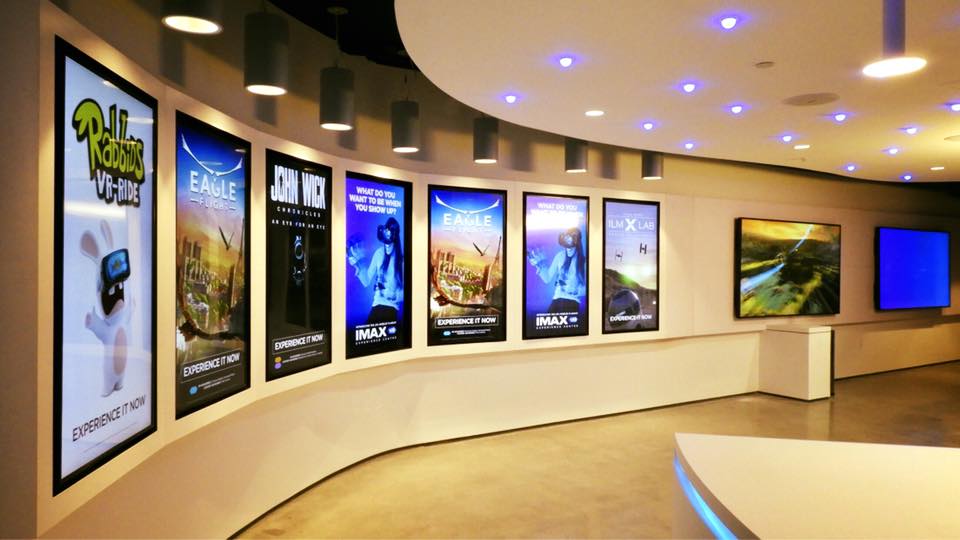IMAX project leverages digital signage throughout VR arcade experience

In August 2016, IMAX started a project that helped thrust virtual reality into the mainstream – the IMAX VR arcade. Mashable described it as an experience that is “indistinguishable from a normal movie theater when you enter in the lobby,” but extraordinary once you enter the “inner VR facility,” which is equipped with different VR equipment.
Bobby Kelley, managing director at PixelFly, was part of the project from launch to completion. PixelFly’s role was to recommend hardware, including displays with media players and a sound system for the entire building. Kelley’s team designed then installed equipment and provided basic training to the IMAX team to run it.
According to Kelley, the project was developed specifically to be a leader in VR experiences, beyond what’s been offered by other VR arcades and home gaming systems. Specifically, the project was meant to re-create experiences that coincided with IMAX’s movie portfolio, “so one can sort of participate in the movie,” Kelley said.
There are also other games that are part of the project that are not movie related.
PixelFly’s signage is a large part of that experience, Kelley said. The moment customers walk in, they see two video walls to the right. On the left, the space opens to seven 55-inch 4K animated “movie posters,” telling them what experiences are playing today.
Behind the ticket counter is an 86-inch 4K monitor with “showtimes” available. Then, as they move to the waiting area, they see four more 86-inch 4K monitors showing commercials for upcoming experiences, short how-to videos on how to set up once inside and quick tips. Once their showtime is available, an ambassador walks the player to his pod, which is an 8-by-8-foot cubical, where they’re greeted by a 43-inch touchscreen to both choose options and launch the experience, as well as let a friend see what they see within the VR headset.
Once the VR experience is done, they are taken to the “decompression room” with the two video walls. There is a 2-by-2 seamless wall of four 55-inch monitors, and a 1-by-3 wall of 86-inch 4K monitors in portrait. Players can take selfies in front of those, watch commercials for IMAX and more.
“The entire experience, with the exception of the 10 to 15 minutes in VR, is direct interaction with the signage. Every screen has a purpose and every screen is used,” Kelley said.
Since the project launched, IMAX has been measuring its success by media and social media impressions, as well as the number of users and revenue growth. As of the summer, the company had surpassed its own revenue projections. The success has been a boon for PixelFly as well.
“We’re enjoying the fact that the customer and their customers are enjoying the entire experience, from the moment they walk in, to the moment they walk out and beyond, with continued discussion and social media shares,” Kelley said.
Interestingly, Kelley said he’s not convinced virtual reality is going to play a big role in digital signage in the near future. He does, however, believe augmented reality will, “especially with Apple enabling their devices with AR specific functionality.”
“And, once Microsoft or Google make AR a little more accessible via new generation Glass or HoloLens, other innovators in the space will start a new generation of products we never knew we needed,” he said.
In the meantime, the IMAX project is finished for PixelFly except for minor maintenance and occasional support. Kelley said IMAX has discussed expansion to other venues, but since most of those venues are movie theaters with their own AV teams, the projects will likely be done internally.
Background
PixelFly got involved in the extensive project through Jim Gentili, who was in charge of the project as head of Retail Design and Operations. He is a longtime client and has used PixelFly’s services during other phases of his career as well, including Tesla and Lexus.
 “It is the best example of having a great relationship. He is tough and has high expectations and we deliver by meeting or beating them. He has since left IMAX, so we hope to have new challenges from him soon,” Kelley said.
“It is the best example of having a great relationship. He is tough and has high expectations and we deliver by meeting or beating them. He has since left IMAX, so we hope to have new challenges from him soon,” Kelley said.
PixelFly engaged a number of other partners to help with the project, starting with LG Pro, which calibrated the monitors and video walls after installation. BrightSign, LG and Crimson ran point for the displays, players and mounting solutions, respectively. Bose Professional provided the sound system. Equipment was also purchased from distribution partners Almo, TechData and ADI Corp.







